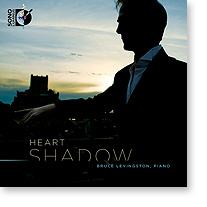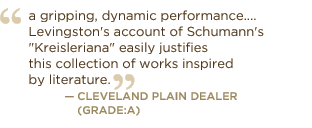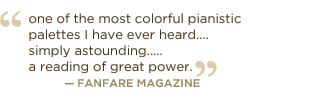

Heart Shadow by Bruce Levingston
PREFACE
The written word has always played an important role in the creation of works of music, from the ancient writings of Plato, Aristotle and Sophocles, to Gogol, Baudelaire and Tolstoy, through modern writers and poets such as Frost, Eliot, Joyce, and Mann. The three works presented here on this album were each inspired by a work of literature. Rather than depicting actual characters, each piece presents a state of mind and soul, a distilled essence of the feelings and emotions found in the original sources. The Schumann is, of course, one of the masterpieces of the piano repertoire; it's depth and beauty endless. It's inspiration came from the Romantic work of E.T. A. Hoffman. The Bielawa and Wuorinen works, both written by two of today's most distinguished and important composers, were inspired by works of Rainer Maria Rilke and Salman Rushdie. These three works, like their creators and muses, could not be more different in compositional style and techniques. Yet, for all of their differences, outwardly as well as inwardly, they seem to share a spiritual unity. Perhaps the basic humanity that is central to each piece somehow joins them musically and artistically. In any case, their beauty, vision and eloquence speak for themselves.
Schumann: Kreisleriana,Op. 16
Robert Schumann
Note by Bruce Levingston
"Anything that happens in the world affects me; politics, literature, people, I reflect about these things in my own way and these reflections then seek to find an outlet in my music." Schumann wrote these words in 1838, the year he produced Kreisleriana. Schumann considered this one of his finest works and wrote: "I like Kreisleriana best of all... Kreisler is an eccentric, wild and gifted Kappelmeister, a character created by E.T.A. Hoffmann."
Kreisler appears in Hoffmann's 1820 novel Katur Murr (Murr the Cat). A satirical work inhabiting the German Romantic world of the fantastic and supernatural, it appears in the form of a duel 'autobiography' belonging to both Kreisler and his cat, Murr. When Kreisler sets out to write an 'autobiography', his preternatural cat decides to do the same. Penning his views while his master sleeps, Murr makes use of the empty sides of Kreisler's manuscripts. Both autobiographies are 'mistakenly' published together resulting in a whimsical, sometimes hilarious mix of narrative and personal opinion on art, literature, music, society, dogs, cats, and critics!
The mercurial Schumann was naturally drawn to this colorful fantasy, finding a kindred spirit with the "eccentric" Kreisler, and aptly subtitled his cycle Eight Phantasies. Utilizing the novel's technique of swiftly alternating moods and perspectives, Schumann captures the kaleidoscopic ambiance of Hoffmann's world by contrasting episodes of tender lyricism with those of wild impetuosity. Though the eight individual pieces are untitled and essentially abstract, Schumann vividly portrays in them the personalities of his alter ego Kreisler as well as his mischievous cat, Murr. There can be little doubt that in the playful yet passionate finale, with its ghostly, feline figurations, the composer, displaying typical Hoffmannesque humor, gives Murr the last word.
Elegy-Portrait
Note by Lisa Bielawa
Dedicated to the memory of Alexandra Montano, a beautifully gifted mezzo-soprano and friend, Elegy-Portrait was built from the materials for a song that was never completed. It was originally to have been part of my song cycle "The Lay of the Love and Death," which had its world premiere on the same Premiere Commission concert at Lincoln Center in 2006 that brought Bruce Levingston, Alexandra and me together for our one transcendent evening of music-making together, an evening that I will always remember as one of the most spiritually gratifying musical experiences of my life. Two years later, after we had lost her, the fragments of this unfinished song invited me back to the feeling we all shared that night. The piece grew and grew - it took on a much broader, wordless form and kept opening itself up to new directions and emotional terrains.
Intending to write a proper elegy - in memory of a friend - I discovered that, while an elegy is all about our own feelings of loss, therefore always cycling back to ourselves, a portrait in memoriam can bring us out of ourselves and into a clearer appreciation of those we loved (and still love). So - the piece started out as an elegy and ended up being a portrait of Alexandra's unique musical spirit.
Heart Shadow
Note by Bruce Levingston
I met Wuorinen the same evening I heard Haroun. Its emotional and sonic beauty overwhelmed me. Soon after, I asked Wuorinen if he would consider making a piano work out of some of my favorite parts. He agreed. But the result is no mere transcription. Wuorinen began with the "cells" (like Brahms in his late works) of the pieces I mentioned to him and developed them into a completely new and different composition. For the most part he retained the yearning ambiance of my favorite aria, "Heart Shadow", but added a ferocious coda that is filled with some truly biting surprises (possibly as a reminder of what is at stake in terms of freedom in the world today). And for a little comic relief, Wuorinen, with his mischievous, dark sense of humor slyly slips in the Goldfinger theme from the James Bond movie series. Even this most formidable of composers shows us that, even when dealing with dire matters, one must keep a sense of humor. Ultimately, however, the piece is autumnal in nature, expressing a longing for a state of mind and being that is always just out of reach. It is indeed one of Wuorinen's most beautiful and intimate works.






